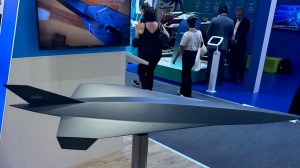In what may mark a great surge forward in fighter jet technology, France has unveiled its Espadon hypersonic fighter concept, signalling a possible redirection of its sixth-generation fighter ambitions.
Breaking Defense reported that French state-backed research company Onera showed its Espadon hypersonic fighter concept this month at the Paris Air Show.
The report mentions that the Espadon model has already undergone wind testing, with the intent of developing an aircraft that can fly at Mach 5 or faster.
It also notes that the concept will be handed over to French industry to prepare for the future, with 2050 as the envisioned date for the hypersonic aircraft’s first flight.
Breaking Defense says that while the French Ministry of Defense (MOD) has not yet funded Espadon at the procurement level, it has been internally funded to improve hypersonic aircraft knowledge and competency, and decide the building blocks to create a prototype.
It also mentions that expertise from Espadon continues to be shared with parties involved in developing France’s Future Combat Air System (FCAS) program built around a Next Generation Fighter, Remote Carriers and an Air Combat Cloud.
At its core, Espadon may be one of multiple sixth-generation fighter concepts under development. Those include the US’ Next Generation Air Dominance (NGAD), Japan’s Global Combat Air Program (GCAP) and the UK’s Tempest projects.

While there is no universally agreed definition of what constitutes a sixth-generation fighter, the type will most likely include new and emerging technologies such as modular design, machine learning, artificial intelligence, virtual and augmented reality, drone swarms and optionally-manned capability.
Although the Espadon’s design details are scant, the idea is strikingly similar to the US Mayhem project, touted to be the successor to the SR-71 spy plane of Cold War fame.
Asia Times reported in December 2022 that the US Air Force awarded Leidos, a Virginia-based private defense company, a contract to deliver “a larger class air-breathing hypersonic system capable of executing multiple missions with a standardized payload interface, providing a significant technological advancement and future capability.”
Project Mayhem is envisioned to perform multiple missions such as delivering area effect or unitary payloads or conducting intelligence, surveillance, and reconnaissance (ISR) missions. The aircraft is to be powered by a turbine-based combined cycle (TBCC) powerplant scheme.
TBCC propulsion uses both jet engines and scramjets to offset the limitations of either engine type. Jet engines would boost the aircraft during takeoff and reach the required speed for the scramjets to kick in for hypersonic flight.
However, many details are still unknown about Project Mayhem. In particular, it is unknown whether it is designed to be a reusable or expendable aircraft, as it has been described as somewhere between a hypersonic missile and a full-on hypersonic aircraft.
Espadon may be part of France’s efforts to push on with FCAS development, which may be stalled due to its contentious partnership with Germany, one of the program’s major stakeholders.
Asia Times noted in November 2022 that Germany’s purchase of 35 F-35 jets from the US last March sparked concerns in France that Germany was cooling on FCAS development. However, Germany argues that the F-35s are necessary to ensure its continued role in NATO nuclear-sharing, which is now even more urgent due to the ongoing Ukraine war.
Differing strategic perspectives have also played a role in stalling the FCAS project. France requires power projection capabilities due to its interests in North and Sub-Saharan Africa and the Middle East, alongside maintaining a nuclear deterrent.
On the other hand, Germany has a pacifist political orientation, and its air defense posture emphasizes counter-air capabilities over long-range strikes, alongside its controversial nuclear-sharing agreement with NATO.
Division of labor issues have hounded the FCAS project, with French aerospace firms Dassault and Airbus at odds over the FCAS’ flight control software.
Dassault insists that FCAS software be shared among all project stakeholders, while Airbus insists that its software should be used in the project.
FCAS partners Germany and Spain are likely to insist on full technology access. Still, Airbus provides flight software for the Dassault Rafale and Eurofighter Typhoon and is unlikely to cede any advantage in that area.
Such disagreements have led France and Germany to postpone replacing their Dassault Rafales and Eurofighters with the FCAS as originally planned from 2040 to 2050. Conflicting national interests between France and Germany may also have dictated the former’s apparent move from the troubled FCAS to the Espadon hypersonic fighter concept.
Dominic Vogel notes in a January 2021 Stiftung Wissenschaft und Politik (SWP) report that France’s capability requirement of unilateral military action contrasts with Germany’s preference for multilateral structures and has hobbled the direction of the FCAS program.
Vogel also notes that France and Germany withhold certain key technologies from each other, with France emphasizing industrial strategic autonomy while Germany stresses maintaining control of its critical military technologies.
He also says that France views the FCAS as the successor to the Rafale for the air-based part of its nuclear arsenal, as it views nuclear deterrence as a critical component of its sovereignty.

That requirement, Vogel says, requires the FCAS to be capable of carrying the ASMP nuclear-tipped cruise missile and the capability to operate from carriers.
In contrast, Vogel notes the more indirect relationship between the FCAS and Germany’s intended nuclear role, as the latter already participates in NATO’s nuclear-sharing program.
He says that, from Germany’s perspective, the FCAS needs to be capable of using US and French nuclear weapons, with France being unlikely to approve given the aircraft’s critical role in maintaining its strategic autonomy.
Hence, France may consider the Espadon program as a new start in its sixth-generation fighter development.

